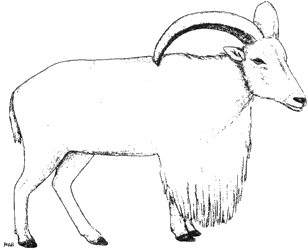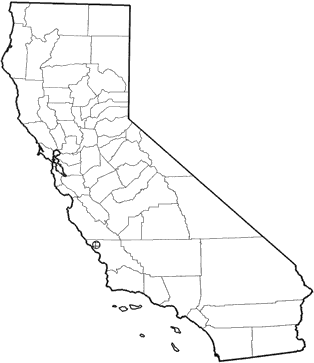
Barbary Sheep
Distribution, Abundance, and Seasonality
Native of mountains of northern Africa. The Barbary sheep is an uncommon resident of the Hearst Ranch in San Luis Obispo and Monterey cos., occurring in valley foothill hardwood and annual grassland habitats. The herd size in 1976 was reported to be about 1200 individuals (Johnston 1979). This introduced ungulate occurs in canyonlands elsewhere in the southwestern U.S. (Gray and Simpson 1980).

Range Map
Specific Habitat Requirements
Feeding: Barbary sheep in California feed primarily on grasses and forbs, and to a lesser extent on browse (Barrett 1966, 1979, Johnston 1979). Browse may be important during the summer months (Ogren 1965, Johnston 1979). A variety of food plants used in the southwestern U.S. Grasses generally important when available, browse may be important yearlong in some locations (Gray and Simpson 1980).
Cover: Barbary sheep seek cover in rocky areas, particularly during the spring lambing season. Woodland also is used for cover.
Reproduction: Rocky outcrops, cliffs, and steep, rugged areas are used for lambing. These rocky areas provide protection from predators and disturbance.
Water: No data found.
Pattern: During fall and winter, Barbary sheep spent 80% of their time in annual grasslands. Oak woodlands were important during hot summers (used 60% of time observed). Rocky areas were extremely important during the spring lambing season.
Species Life History
Activity Patterns: Active yearlong; primarily diurnal.
Seasonal Movements / Migration: None reported.
Home Range: No data for California. The size of home ranges varies tremendously, depending on environmental conditions (Solbert 1979). Barbary sheep generally occur in separate male and female/young herds, except during rut. Bachelor herds consist of 4-6 males.
Territory: Males fight for access to females. A linear dominance hierarchy exists within each sex and age class. Males are dominant to females, which are dominant to young.
Reproduction: Mating peaks in December, but may take place at any time of year. Gestation 22-23 weeks. Young born mainly from March-May. Ewes produce an average of 1.2-1.3 lambs per pregnancy. Although capable of producing 2 sets of twins/yr, probably lamb only once a yr (DeArment 1971, Barrett 1979). All females are mature by 19 mo of age (Ogren 1965).
Niche: This introduced grazer may compete on the Hearst Ranch with other exotic ungulates, native black tailed deer, and livestock. Potential predators are mountain lions, bobcats, and coyotes. Barbary sheep carry bluetongue virus, and potentially are serious competitors with bighorn sheep, if introduced into bighorn habitat (Barrett 1967, Simpson et al. 1978). Also called aoudad.
Sources & References
California Department of Fish and Game, 1999.
California's Wildlife, Sacramento, CA.
Written by: R. A. Hopkins, reviewed by: H. Shellhammer, edited by: J. Harris, R. Duke
Barrett, R. H. 1966. History and status of introduced ungulates on Rancho Piedra Blanca, California. M.S. Thesis, Univ. Michigan, Ann Arbor. 141pp. Barrett, R. H. 1967. Some comparisons between the Barbary sheep and the desert bighorn. Trans. Desert Bighorn Counc. 11:16-26. Barrett, R. H. 1979. History of the Hearst Ranch Barbary sheep herd. Pages 46-50 in Proc. Symposium on Ecology and Management of Barbary Sheep. C.D. Simpson, ed. Dept. Range and Wildl. Manage., Texas Tech Univ., Lubbock. 112pp. DeArment, R. 1971. Reaction and adaptability of introduced aoudad sheep. Texas Parks and Wildl. Dep., Div. Fed. Aid Wildl., Restoration Proj. No. W-45-R-21. Final Rep. 20pp. Gray, G. G., and C. D. Simpson. 1980. Ammotragus lervia. Mammal. Species No. 144. 7pp. Johnston, D. S. 1979. Habitat utilization and daily activities of Barbary sheep. Pages 51-58 in Procs. Symposium on Ecology and Management of Barbary Sheep. Texas Tech. Univ., Lubbock. 112pp. Ogren, H. A. 1965. Barbary sheep. New Mexico Dep. Fish and Game Bull. No.13. 117pp. Simpson, D. C., L. J. Krysl, D. P. Hampy, and G. G. Gray. 1978. The Barbary sheep: a threat to desert bighorn survival. Desert Bighorn Counc. Trans. 22:26-31. Solbert, A. G. 1979. Social organization and behavior of aoudad (Ammotragus lervia pallas) in Texas. Pages 66-72 in C. D. Simpson, ed. Proc. Sympos. on Ecology and Manage. of Barbary Sheep. Texas Tech. Univ., Lubbock. 112pp. Zuckerman, S. 1953. The breeding seasons of mammals in captivity. Proc. Zool. Soc. London 122:827-949.
California Animal Facts | California's Wildlife